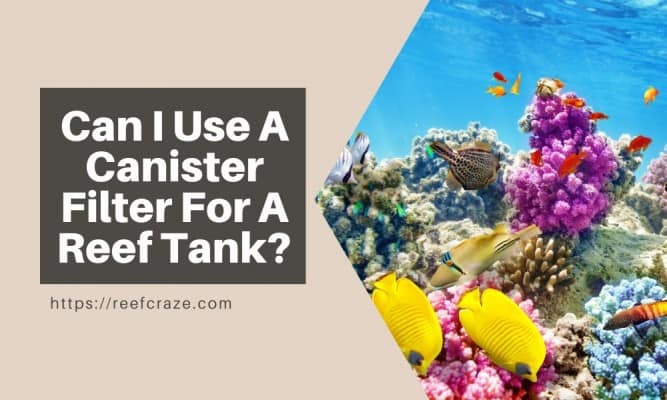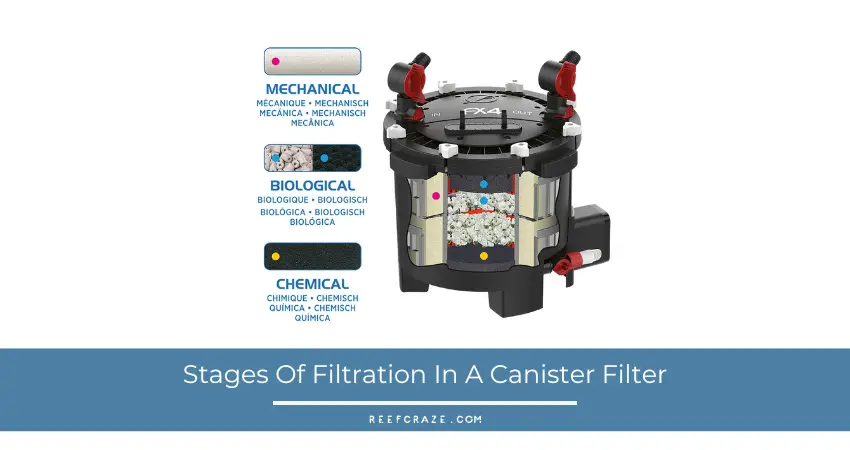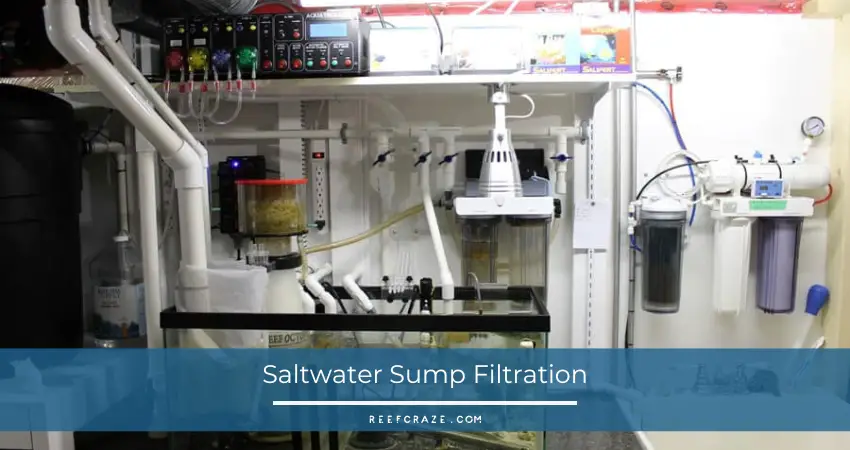A canister filter is capable of handling all the filtration needs of a reef tank. It actively forces the water of a tank to enter the canister and pass through the media and makes sure that the water cannot get any chance to channel around the media. It means that a canister filter is very good at getting your tank water in contact with the filter media.
You can use a canister filter for a reef tank. You can use it for mechanical, biological, and chemical filtrations. It can also be used as the sole filtration system or combined with other types of filtration systems in your tank.
To learn about how you can use a canister filter for each of the purposes mentioned above, go through the full article. I am sure you will get all the things you should know about using a canister filter for your reef tank.

How Can I Use Canister Filter As A Mechanical Filtration System?
If you have an under gravel filtration system in your tank, you can use a hang-on-tank canister filter as a new addition. It will remove the free-floating solid and liquid particles that usually get trapped in the substrate. If you continue using a canister filter in this kind of reef tank setup, it will improve the water quality.
If you have a semi-reef system with some fish and live rock, you can use a canister filter as a pre-filter. It will remove unwanted wastes and detritus from the tank water before they pass through the biological filter (i.e., a wet/dry trickle filter) or the main water supply (i.e., a sump system).
You can also use it if you have a full reef system with corals and live rock. But in that kind of system, this mechanical filtration may filter out the beneficial plankton life from the water that marine organisms need to survive.
A hang-on-tank canister filter is widely used as a mechanical filtration system during regular tank maintenance and cleaning routines. It is one of the easiest and simplest ways to keep amphipod as well as copepod larval blooms (those tiny white bugs that you often notice floating around in your tank) under control.

How Can I Use Canister Filter As A Biological Filtration System?
A lot of canister filters are designed to work as a biological filtration system and many hobbyists use them as a biological filter. But it is not the best choice to use it as the main source of this kind of filtration.
You may use it if you have a small reef system. Otherwise, it is better if you do not use it for this purpose because most of the canister filters do not have a chamber large enough to hold a good amount of bio-media. However, you can still use it as an addition to other types of biological filters, for example, maybe with a wet/dry trickle filter or live rock where it can work as a mechanical filtration system.
Remember that there are some factors to be taken into consideration. One of the important factors is the rate of the water flow – it’s not how much the manufacturer says it will be, but how much it actually will be when the other factors are considered. But worry not – they will also be discussed here eventually.
How Can I Use Canister Filter As A Chemical Filtration System?
You can use a granular activated carbon (GAC) in the chamber of the installed canister filter in your tank. It will come in handy when you work on any problem concerning the water quality. Just place the GAC in the filter’s chamber.
It will make all the medications, odors, and contaminants go away. It will also use the absorbing products that are used to remove phosphates, nitrates, silicates, and other unnecessary chemical compounds from the water.
You can also use this filtration system to filter fresh tap water before you use the water to add as top-off water or to prepare saltwater for your reef tank.
Is It Okay To Canister Filter As The Sole Filtration System?
Yes, it is okay. I already said that you can use it as the sole filtration system. But make sure you keep it clean and well-maintained regularly.
What If I Want To Use It With Other Filtration Systems?
A canister filter has to be cleaned at least once a month in order to maintain its effectiveness. Therefore, using it with other filtration systems will be a better option for you if you think you cannot keep it properly maintained. In this way, you can also avoid the problems that occur when the filter gets clogged.
You already know why you should use a different filter if you want to use a canister filter as a biological filtration system. If you still decide not to use a different one, use at least two canisters for a medium-sized tank. If you have a large one, using it with other filtration systems is the only option for you.
If the cost is too much for you, you should use a sump system. It is durable and will work just fine as a single filtration system for your reef tank.

What Do I Have To Consider For The Water Flow Rate?
The water flow rate that the instructions of the manufacturer say is the one when the filter is empty and the head pressure is zero which means the canister is not pumping the water uphill.
So, you have to consider two important things as they directly affect the canister filter’s flow rate.
- Using extra media like carbon or some filter materials like micro pleat cartridges, poly filters or floss, sponges, etc. inside the canister’s media chamber will affect the flow rate.
- A canister filter is usually placed underneath a tank and so it has to deal with a lot of head pressure, and maybe with a long-distance hose too through which the water will travel.
For a hang-on-back canister, the water flow rate will be around what the manufacturer says since it will have little or no head pressure to deal with.
When you take the above two things into consideration, you can get the actual rate of the water flow after you install and run the filter in your tank. After considering the other factors and getting the flow estimate if you are still unsure about your choice, you can buy a larger canister filter instead of the one you already bought.
You can never do the water turnover too many times. But you may face problems if you do not do it enough since it can make the water quality poor. It is recommended that the water is turned over at least 6 to 10 times per hour.
What should be the ideal flow rate of your reef tank? [Read More]
What Are The Other Factors To Consider?
There are different types of canister filters available in the market. Some of the popular ones are Magnum, Eheim, and Fluval. But whichever canister filter you buy, it will differ from the others as each has its own features and designs. So, if you are planning to buy one, do some research first. It will help you find the type of canister you need.
However, there is a special type of canister known as ‘pressurized filters’. Using it will noticeably increase your electric bills. So, be very sure if you want to buy it. However, using it periodically would also be a good idea.
The simplest way to determine what type of canister you need is to figure out what function you want it to perform. It will narrow down your options within a blink.
I have already mentioned that a canister filter has to be cleaned at least once a month. If you don’t do so, your canister filter will not run at its full capacity. It will also slow down the water flow rate.
Now, here are the factors to be considered that can help to prevent a canister filter from having its efficiency and water flow rate diminished.
- Place the filter in an easy spot so you don’t have to struggle to get it out of the tank for cleaning.
- If the filter manufacturer offers extra tools to clean the filter in an easier and faster way, use them. They are very helpful.
- You can consider purchasing extra materials like sponges, floss, etc. They will help you clean the filter faster.
- You will notice the water flow rate slowing down when the canister’s filtration material becomes dirty. That filtering material/media needs to be changed or cleaned at least once a week. If left uncleaned, the flow rate will decrease and wastes will get jammed in your reef system. Consequently, the water quality will become poor.
But if you use the canister only for biological filtration purposes, cleaning the media once a week won’t be necessary for you.
- Since calcium, salt crystal, and algae can occur inside the canister’s chamber, hoses, impeller, and other areas where water travels through, you will have to take the entire filter completely apart, separate all the sections, and clean them thoroughly.
- One of the common problems that come with canister filters is the nitrate issue. The decomposition of debris and detritus inside a canister filter causes the nitrate levels to increase dramatically.
It is an unavoidable problem. The only way to keep it under control is to never allow the nitrate levels to go above 5 ppm. Otherwise, the nitrates will cause the algae to grow rapidly.
Final Words
A canister filter is suitable for reef tanks. It is a versatile tool that you can use for several purposes. It is perfect at keeping the tank water clean. However, always make sure that you keep it well-maintained so that it can function flawlessly.
Remember that a dirty canister filter will result in poor water quality which again will result in stressed and sick tank inhabitants.
That’s all about canister filters. I hope you have got everything you were looking for from the article. Thanks for reading!
